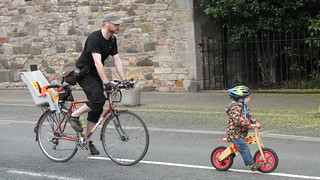If I was someone important from PoP, I would send something along the following lines to Chris Hoy's management. Cribbed from the PoP manifesto.
Dear Sir / Madam
I see from press reports that Keith Brown MSP, minister for housing and transport, will be meeting with Sir Chris to find out more about what he thinks should be done to boost bike use in Scotland.
This is a critical time for cycling in Scotland. There is a relatively short time in which to capitalise on the enormous success of Sir Chris and the other TeamGB cyclists at the Olympics. This year's successes have given huge prominence to cycling and it is important that the Government sees boosting cycling as a transport issue. Children's love of cycling is built on using bikes for play and transport and safety is a critical concern of parents.
Sir Chris gave his support to Pedal on Parliament on 28 April 2012 and I know that he is well aware of the issues around cycling in Scotland but below I have summarised some of the key points from the Pedal on Parliament manifesto which might be useful as talking points in the discussion. I would be happy to provide further details on any of these points if that would be helpful.
1) Proper funding for cycling. The Scottish Government spends only 1p of every pound spend on transport on cycling. Boosting cycling needs investment in the type of infrastructure that will make people feel safe cycling. We recommend that the Scottish Government commits 5% of its transport budget on cycling and urges all Scottish councils to do the same.
2) Design cycling into Scotland’s roads. Most collisions between vehicles and bikes take place at junctions. Improved provision for cycling must include a commitment to transforming Scotland’s roads and junctions. The existing design guidelines, Cycling by Design,[13] should be revised in line with best practice internationally – particularly drawing on the experience of the Netherlands where 25% of trips are by bike.
3) Safer speeds where people live, work and play There are significant road safety benefits to a 20 mph speed limit.[16] In residential areas, the presumption should be that roads authorities should apply 20mph speed limits as the norm in these areas.
4) Integrate cycling into local transport strategies Each local authority should be required produce its own local cycling action plan with clear targets to increase cycling levels in line with the national target of 10%, using the existing cycling levels as a guideline. Funding to support this should be ring-fenced and councils required to report against their progress every year.
5) Sensible road traffic law and enforcement Traffic law must do more to protect the most vulnerable road users such as cyclists, pedestrians, children and older people. Enforcing speed limits, creating and enforcing parking restrictions in cycle lanes are essential to creating a safe environment for cycling.
6) Reduce the risk of HGVs to cyclists and pedestrians Heavy lorries are associated with a disproportionately high risk of death or very serious injury to cyclists and pedestrians. Despite being just 6% of road traffic, lorries are involved in around 20% of all cyclists’ fatalities.[17] CAPS already has targets for reducing cycling casualties but the onus must not just be on the cyclists to keep themselves safe. The Scottish government should engage with the UK Department of Transport with a view to developing a comprehensive package of measures to reduce the risk to cyclists and pedestrians, based on up to date evidence of what works.
7) A strategic and joined-up programme of road user training Bikeability is not fully funded, and Cycling Scotland is dependent on volunteers to carry out vital training in schools. All Scottish residents should have access to affordable cycle training, whether children, adult returning cyclists, and those in later life. The training of HGV drivers, bus drivers and other professional drivers should include awareness of the needs of both pedestrians and cyclists, and the Scottish government should press the UK government to introduce these measures.
8) Solid research on cycling to support policy-making Data on cycling is very poor at the national level and inconsistent at the local level. This makes it difficult to monitor what is happening and which interventions have greatest impact. Where possible electronic counters with public displays should be used, as in Copenhagen and other cities, which count the number of cyclists passing through certain areas as these can provide both feedback and encouragement.
manage@chrishoy.com

 posts
posts
